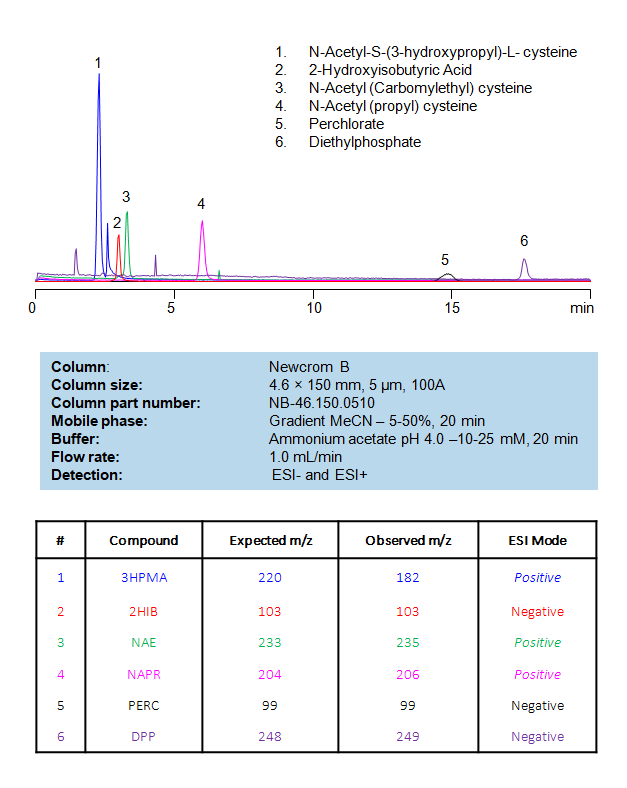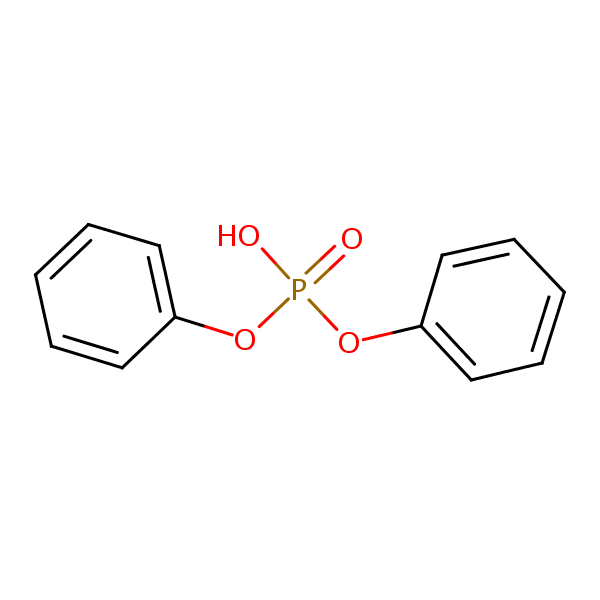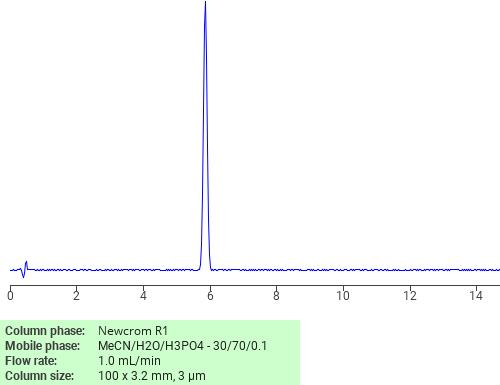| CAS Number | 838-85-7 |
|---|---|
| Molecular Formula | C12H11O4P |
| Molecular Weight | 250.191 |
| InChI Key | ASMQGLCHMVWBQR-UHFFFAOYSA-N |
| LogP | 1.70 |
| Synonyms |
|
Applications:
HPLC-MS Method for Separation of Metabolites and Biomarkers on Newcrom B Column
September 8, 2023
HPLC Method for Separation and Analysis of Acidic Toxin Metabolites with an MS-Compatible Mobile Phase on a Newcrom B Column by SIELC Technologies.
Separation type: Liquid Chromatography Mixed-mode

Metabolites and biomarkers are key terms in the fields of biochemistry, pharmacology, and medicine.
- Metabolites:
- Definition: These are small molecules produced during metabolism, which is the set of chemical reactions that occur within cells to maintain life. Metabolites can be either products of metabolism or the substrates used in metabolic reactions.
- Types: There are primary metabolites, which are directly involved in normal growth, development, and reproduction (like amino acids and sugars), and secondary metabolites, which often have specialized roles such as defense mechanisms in plants (like alkaloids or antibiotics).
- Uses: In the context of drug testing, for instance, the presence of certain metabolites can reveal whether someone has taken a specific drug, even if the drug itself is no longer present in the person’s system.
- Biomarkers:
- Definition: A biomarker, or biological marker, is a measurable indicator of some biological state or condition. Biomarkers are often used to assess the risk or presence of disease, to monitor the progress of disease, or to see how the body responds to a treatment.
- Types: Biomarkers can be specific cells, molecules, genes, enzymes, hormones, or metabolites. They can also be measurements like heart rate or blood pressure.
- Uses: In medicine, biomarkers can be used for early disease detection (like elevated PSA levels indicating potential prostate cancer), monitoring disease progression (like HIV viral load tests to see how well antiretroviral treatment is working), or understanding disease mechanisms. They can also be used to see if a body has been exposed to certain harmful substances, indicating potential harm or risk.
N-Acetyl-S-(3-hydroxypropyl)-L-cysteine (3HPMA) is a common metabolite of the herbicide and pollutant Acrolein. 2-Hydroxyisobutyric Acid (2HIB) is a neuro and adrenal toxin that is a common metabolite of the fuel additives Methyl tert-butyl ether (MTBE) and Ethyl tert-butyl ether (ETBE). N-Acetyl(Carbomylethyl)cysteine (NAE) is a metabolite of Acrylamide which can act as a neuro toxin in cases of long term exposure. N-Acetyl(propyl)cysteine (NAPR) is a metabolite of the popular industrial organic solvent 1-bromopropane (1-BP). Perchlorate (PERC) inhibits thyroid activity and can be used to treat hyperthyroidism, but can be toxic in large amounts or in regularly-functioning thyroids. Diphenylphosphate (DPP) is a metabolite of the popular flame retardant triphenyl phosphate (TPHP). These acidic toxin metabolites can be retained, separated, and analyzed on a mixed-mode Newcrom B column with a mobile phase consisting of water, Acetonitrile (MeCN), and Ammonium Acetate (AmAc). This analytical method can be detected with high resolution and peak symmetry with many evaporative detection methods, including Evaporative Light Scattering Detection (ELSD), Charged Aerosol Detector (CAD), and Electrospray Ionization (ESI) for Mass Spectrometry (MS).
High Performance Liquid Chromatography (HPLC) Method for Analyses of Michler’s ketone
Condition
| Column | Newcrom B, 4.6 x 150 mm, 5 µm, 100 A |
| Mobile Phase | Gradient MeCN/H2O – 5-50%, 20 min |
| Buffer | Gradient Ammonium acetate pH 4.0 –10-25 mM, 20 min |
| Flow Rate | 1.0 ml/min |
| Detection | ESI- and ESI |
Description
| Class of Compounds | Metabolites and Biomarkers |
| Analyzing Compounds | Metabolites and Biomarkers |
Application Column
Newcrom B
Column Diameter: 4.6 mm
Column Length: 150 mm
Particle Size: 5 µm
Pore Size: 100 A
Diphenyl phosphate
N-Acetyl (Carbamoylmethyl) cysteine
N-Acetyl-S-(3-hydroxypropyl)-L-cysteine
N-Acetyl-S-propyl-L-cysteine
Perchlorate

Separation of Diphenyl phosphate on Newcrom R1 HPLC column
February 16, 2018
Diphenyl phosphate can be analyzed by this reverse phase (RP) HPLC method with simple conditions. The mobile phase contains an acetonitrile (MeCN), water, and phosphoric acid. For Mass-Spec (MS) compatible applications the phosphoric acid needs to be replaced with formic acid. Smaller 3 µm particles columns available for fast UPLC applications. This liquid chromatography method is scalable and can be used for isolation impurities in preparative separation. It also suitable for pharmacokinetics.
Application Column
Newcrom R1
The Newcrom columns are a family of reverse-phase-based columns. Newcrom A, AH, B, and BH are all mixed-mode columns with either positive or negative ion-pairing groups attached to either short (25 Å) or long (100 Å) ligand chains. Newcrom R1 is a special reverse-phase column with low silanol activity.
Select options




